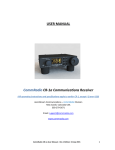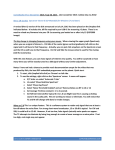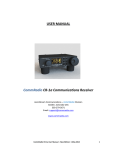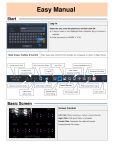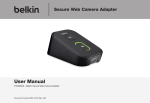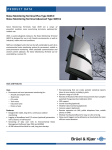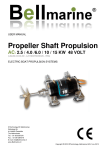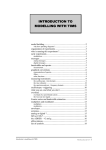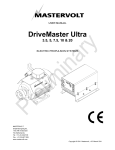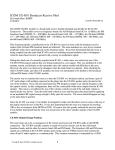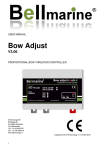Download USER MANUAL CommRadio CR-1 Communications Receiver
Transcript
USER MANUAL CommRadio CR-1 Communications Receiver AeroStream Communications – CommRadio Division 1717 Washington Ave – Suite 10 Golden, Colorado 80401 USA 303-279-3671 Email: [email protected] www.commradio.com CommRadio CR-1 User Manual – Revision 1: 25 October 2013 1 A. Introduction. Thank you for purchasing a CR-1. The CR-1 is meant to be intuitively obvious and fun to use; not requiring a manual close at hand. The CR-1 was designed to have minimal controls and no deep-menu options, yet be fast and efficient changing bands and modes. This manual is intended to describe the basic controls and some features that are not obvious. Firmware Updates. Contact [email protected] to register your warranty and to automatically receive automated email notices when updates to firmware or this manual are available. Definitions: CW: CCW: Push: Click: Increment: Scrolling: Clockwise rotation of a knob. Counter-clockwise rotation of a knob. Momentarily push inward on a knob (<0.5 seconds) Rotate the Menu knob (1) one detent CW or CCW. Rotate the Tuning knob (3) a few degrees CW or CCW. use [<] and [>] keys to step through options shown on display. Symbols: Bold square brackets [ ] denote user interaction with knobs and keys: Example: [BAND] denotes pushing the BAND key in the figure below. Example: [T] denotes pushing or rotating the Tuning knob (3). B. Front Panel Controls CommRadio CR-1 User Manual – Revision 1: 25 October 2013 2 1: Menu Knob [M] Encoder-12 detents per revolution with push-in in switch. switch Description: Rotary Encoder Use: ON/OFF – Volume – Menu On/Off Control: Push [M] to turn - ON. Hold [M] to turn - OFF • Volume (default): a cclick of the knob independently controls the Head-set and speaker volume. There is no indication of the volume level on the display. • Menu: Push-In [M] momentarily for Menu Selections that include: o Filter Bandwidths o Frequency Range Selections o Squelch o Control features o Configuration 2: Display: 128 x 64 pixel x 1.5”diagonal OLED. Organization: a. b. c. d. e. f. Frequency Band Mode is active (highlighted (highlight box) Signal Strength: S-Units Filter Bandwidth Power Icons CommRadio CR CR-1 User Manual – Revision 1: 25 October 2013 3 3: Frequency Tuning Knob [T] Description: Rotary Encoder-15 increments (no detents) per revolution With push-in switch. Primary Use: Frequency Selection. Secondary Use: Push once to highlight frequency cursor. Then, rotate to re-position frequency cursor. Push again to exit. 4: Key-Pad Radio Controls: [BAND] Change Bands [MODE] AM-CW-LSB-USB-FM [SCAN] Frequency Stepping [MEM] Frequency Save-Recall [<] Left Arrow-Selection [>] Right Arrow-Selection [<] and [>] positions the highlighted cursor as a default. When [BAND] [MODE] [SCAN] or [MEM] are pushed, then [<] and [>] are used for associated selections by viewing the change on the display. [LAST]: Holding the [<] key will return the radio to the last frequency that was maintained for at least 5 seconds prior to pressing the key. This allows a rapid return to a prior frequency, regardless of band. 5. Headset Jack: 3.5 mm (1/8”) female-stereo-jack. Conventionally wired for typical ear-bugs or headset. Delivers: 40 mW into 16 Ohms. Use this jack for amplified speakers or sound-card interfaces. CommRadio CR-1 User Manual – Revision 1: 25 October 2013 4 C. Operating the CR-1 1. On/Off - Volume - Menu Knob [M] • ON: Push-In momentarily until………………….. In 4 seconds the CR-1 is ready and displays the last frequency and mode used before the last shut-down. • OFF: Push-In and hold until………………………… Release and then wait 3 seconds……….. If the CR-1 does not shut down in 3 seconds, hold-in (about 6 seconds) to force shut down. 2. Tuning Step Size - Frequency Cursor Positioning • Cursor Positioning – Decade Control The solid-highlighted boxes below indicate the position of the Cursor. When the tuning knob [T] is rotated CW or CCW, the tuned frequency changes accordingly. There are 2 ways to change the position of the cursor: • • • Use [<] or [>] to position the cursor. This is the default use of the arrow keys. Press [T] and rotate CW or CCW. Press [T] again to exit. Note the sequence of successive cursor position changes. Push [>] 3 times Push [>] 3 times CommRadio CR-1 User Manual – Revision 1: 25 October 2013 5 • Cursor: Open Box – Standard Frequency Steps: An open box indicates a standard frequency step size within a band. This occurs only if ‘Automatic Tuning-Mode’ is selected (see Menu below). • 5 kHz step in international broadcast bands (10.000 MHz). 200 kHz step in US FM broadcast band (88.100 MHz). Cursor: Highlighted Box - Standard Frequency Steps - VHF & UHF Highlighted for 25.0 and 12.5 kHz frequency steps, depending on band. 3. Changing Bands [BAND] • • • • • • Push [BAND] Note highlighted box indicating Amateur or Shortwave banding and the current band. < or > to scroll through associated bands. Or: push [BAND] repetitively to scroll upward through bands. Amateur and Shortwave listening bands are listed in section H. To exit: rotate [T], or timeout. 4. Changing Modes [MODE] • • • • Push [MODE] < or > to scroll through modes AM-CW-LSB-USB and FM (above 25 MHz) Or: push [MODE] repetitively to scroll through available modes. To exit: rotate [T], or timeout. CommRadio CR-1 User Manual – Revision 1: 25 October 2013 6 5. Frequency Stepping [SCAN] The CR-1 Steps sequentially through frequencies and does not stop on a channel or frequency if a signal is present. • • • • • Push [SCAN] to start stepping in increments corresponding with the cursor position. Cursor range: 100 kHz to 10 Hz. Steps within the selected band. To stop stepping: Push [SCAN] or rotate [T]. To reverse stepping direction (while stepping): [<] or [>] 6. Memory [MEM]: Save-Recall-Scan • • Save a frequency example: Save 10.000 MHz to Memory page 3, slot 3. Push [MEM]. There are 8 pages of memory. Use [<] or [>] to index through pages. Select page 3. Note the tuned frequency is shown in upper right of display. Push [MEM] to enter the selected page. Use [<] or [>] to index through memory slots. Hold [MEM] 2 seconds. Exit options (return to Main display): • Rotate [T] 1 increment CW or CCW. The frequency will not change until next increment. • Timeout (see selections below). Recall a frequency example: Recall 10.000 MHz from Memory page 3, slot 3. Push [MEM]. There are 8 pages of memory. Use [<] or [>] to index through pages. Select page 3. Note the tuned frequency is shown in upper right of display. Push [MEM] to enter the selected page. Use [<] or [>] to index through memory slots. Select slot 3. Push [MEM]. Exit options if frequency not selected: • Rotate [T] 1 increment CW or CCW. • Timeout (see selections below). CommRadio CR-1 User Manual – Revision 1: 25 October 2013 7 D. MENU. Push the Menu Knob [M] inward momentarily to enter MENU options. 1. FILTER Bandwidth Selections: are the most frequent and therefore the fastest to access using the push-in switch on the Menu knob [M]. The first push [M] defaults to Filter selections: 5 kHz (total bandwidth) is presently selected: A second push [M] highlights the current selection: Rotate [M] CW or CCW to view the available filter bandwidths. The selection is made immediately and is audible. Exit options: Push [M] to continue clicking to next menu selection Rotate [T] 1 increment CW or CCW. The frequency will not change until next increment. Timeout (see selections below). Bandwidth selections are MODE dependent as follows: CW 500 Hz, 1.0, 1.8, 2.2 & 2.6 kHz SSB 1.8, 2.2 & 2.6 kHz AM 2.6, 5, 7.5, & 15 kHz NBFM 15 & 25 kHz FM Broadcast 200 kHz CW clicks of Menu Knob: 2. Frequency Range Selection (HF-VHF-UHF): Next CW Click after the first push of [M]: Push [M] to highlight: Rotate [M] to select HF, VHF or UHF: CommRadio CR-1 User Manual – Revision 1: 25 October 2013 8 Rotate [T] or timeout to return to Main display: Exit options: • Push [M] to continue clicking to next menu selection. • Rotate [T] 1 increment CW or CCW. The frequency will not change. • Timeout (see selections below). 3. Band Key Configuration: Next CW Click of [M]: Rotate [M] to select Shortwave or Amateur [BAND] key configuration. Same exit options. 4. Automatic or Manual Tuning-Mode Controls: Next CW Click of [M]: Switch between automatic and manual frequency step size and mode while tuning through amateur and shortwave bands. Automatic: provides automated mode changes and standard frequency steps. In SSB & CW: 4 rotations of [T] will shift the cursor form 100 Hz to 1 kHz for speed tuning. When rotation stops, the cursor shifts back to the 100 Hz position for fine tuning. To Select: Push [M] to highlight: Rotate [M] to select Automatic or Manual. Same exit options. CommRadio CR-1 User Manual – Revision 1: 25 October 2013 9 CCW Menu Options: are accessed by pushing [M] to enter Menu from the main frequency display. (Filter bandwidth selection is always the default). Rotating [M] CCW accesses options that are less frequently used. Note: all menu items are chained in sequence and can be accessed by successive CW or CCW clicks. 5. AGC Speed: AGC attack time equals AGC decay time. There are 3 speeds available. Press [M] to enter Menu options (filter bandwidth always the default) and rotate [M] 1 click CCW. Exit options: • Push [M] to continue clicking to next menu selection. • Rotate [T] 1 increment CW or CCW. • Timeout. 6. HF Squelch Control: is available up through 30.0 MHz Rotate [M] 1 click CCW past AGC SPEED. Push [M] to highlight. Rotate [M] CW to advance or CCW to retard Squelch. Same Exit options. 7. VHF-UHF Squelch Control: Rotate [M] 1 click CCW past HF SQUELCH. Push [M] to highlight. Rotate [M] CW to advance or CCW to retard Squelch. Same Exit options. CommRadio CR-1 User Manual – Revision 1: 25 October 2013 10 8. Display Brightness Control: Rotate [M] 1 click CCW from VHF-UHF Squelch. Press to highlight. Rotate [M] to adjust brightness. Same exit options. 9. Frequency and Memory Step Time: Steps in increments associated with cursor position. The cursor position is highlighted: Rotate [M] 1 click CCW from Brightness. Press to highlight. Rotate [M] to select: 250, 500 mS, 1-2-5-10 seconds Same exit options. Illustration of stepping sequentially through saved frequencies within a memory page: 10. Timeout from menu options and the [BAND] [MODE] and [MEM] keys is user controllable: 2, 3, 4, and 5 seconds: Rotate [M] 1 click CCW from Step Time. Press to highlight. Rotate [M] to select: 250, 500 mS, 1-2-5-10 seconds Same exit options. CommRadio CR-1 User Manual – Revision 1: 25 October 2013 11 11. Rapid Tune is a feature to rapidly tune across a band in 1 kHz increments when the cursor is normally in the 100 Hz position. This feature is available when ‘AUTOMATIC’ has been selected. Rotate [M] 1 click CCW from Timeout. Press to highlight. Rotate [M] to select: OFF, 2, 4, 6, 8, 10 revolutions. Same exit options. With the cursor in the 100 Hz position, after ‘X’ rotations of [T], the cursor automatically moves to the 1 kHz position until rotation stops. Then the cursor returns to the 100 Hz position to allow for fine-tuning. 12. Broadcasting Plans for USA and the World Frequency tuning steps for: MW are automatically adjusted (10 or 9 kHz) HF amateur allocations. VHF Broadcast (200 or 100 kHz channel spacing) Rotate [M] 1 click CCW from Rapid Tune. Press to highlight. Rotate [M] to select: USA or EUROPE/ASIA Same exit options. 13. Firmware Versions and embedded serial number: Rotate [M] 1 click CCW from BROADCAST. Press to highlight. Rotate [M] to view DSP & PIC version, and the CR-1 serial number. Same exit options. CommRadio CR-1 User Manual – Revision 1: 25 October 2013 12 E. Display Power and Lock Icons Low Battery Normal Battery USB Charging Power Plug Hold [>] to lock and unlock Tuning Knob CommRadio CR-1 User Manual – Revision 1: 25 October 2013 13 F. Rear Panel Controls 6: Power Input Jack. Accepts 5 mm diameter barrel with 2.1 mm diameter center pin (positive). Reverse polarity protected. DC input voltage: 6.0 to 18.0 VDC. Minimum rating of owner-supplied power supply to power radio and charge battery: • • 2 W (without internal battery) 5 W (with internal battery) 7: Powered Mini-B USB Jack. Dual Use: • Supplies power to the CR-1. Charges internal battery if installed. • USB 2.0 connection to Windows PC for updated internal firmware. Notes: Power input jacks 6 & 7: • • • • • With the internal battery installed, either power input jack will charge the battery while the CR-1 is OFF or ON. Both Jacks can be used simultaneously. If both engaged, power drawn only from power input jack 6. Jacks can be engaged-disengaged while the CR-1 is ON. USB Power automatically limited to 2.5 W per USB-Powered PC requirements. Fastest battery charging is via power input jack 6. 8: External Speaker: Internal amplifier delivers 0.8 Watts into 8 Ohm Speaker. 3.5 mm (1/8”) female-mono-jack (tip and ring). CommRadio CR-1 User Manual – Revision 1: 25 October 2013 14 • • Both speaker wires connected to the tip and ring of the external speaker jack MUST be un-grounded to avoid internal amplifier damage. Not intended for sound-card or amplified speakers. See Headset Jack on page 3. 9: MW-HF Antenna Port 1: High impedance input for random wire. 3.5 mm (1/8”) female-mono-jack. Plug connections: • Tip: Antenna • Barrel: Ground 10: MW-HF Antenna Port 2: BNC Female – 50 Ohm. 11: VHF-UHF Antenna Port 3: BNC Female – 50 Ohm. 12: External Chassis Ground Connection: 4/40 Phillips pan-head screw with 2 washers. The CR-1 is designed with ESD diodes on all antenna and power input jacks, knobs and keys. It is good practice to ground the CR-1 to discharge static electricity from antennas and if other equipment is nearby that may cause reception interference. In settings such as a room with indoor antennas, or outdoors with temporary antennas it is not necessary to ground the CR-1. However, during active lightning storms, it is wise to disconnect antennas unless wellprotected with surge devices. 13: Internal Lithium-Ion Rechargeable Battery (not shown). The internal battery is a Tenergy model 30006, Li-18650 3.7V 2600 mAh with internal protection circuitry. 18650 type cells from other manufacturers may not fit the internal battery holder since they vary in diameter and length. Less than 1 gm of lithium is used in this cell and therefore it is well under the limits for cartage on aircraft. It is important to replace with same/similar batteries that have internal protection circuitry. CommRadio CR-1 User Manual – Revision 1: 25 October 2013 15 G. USA Band Plans. International Shortwave Start Stop Number Name Freq Freq Overall 0.150 30.000 0 11 m 25.600 26.100 1 13 m 21.450 21.750 2 15 m 18.900 19.020 3 16 m 17.480 17.900 4 19 m 15.100 15.800 5 21 m 13.500 13.870 6 25 m 11.600 12.100 7 31 m 9.400 9.990 8 41 m 7.100 7.350 9 49 m 5.900 6.200 10 60 m 4.750 5.060 11 75 m 3.900 4.000 12 90 m 3.200 3.400 120 13 m 2.300 2.495 14 AM 0.530 1.710 UHF Start Number Name Freq Overall 437.000 0 FRS2 467.563 1 FRS1 462.563 2 70 cm 438.000 Amateur Number Name Start Freq Overall 0.150 0 10 m 28.000 1 12 m 24.890 2 15 m 21.000 3 17 m 18.068 4 20 m 14.000 5 30 m 10.100 6 40 m 7.000 7 60 m 5.330 8 80 m 3.500 9 160 m 1.800 10 AM 0.530 Stop Freq 30.000 29.700 24.990 21.450 18.168 14.350 10.150 7.300 5.405 4.000 2.000 1.710 VHF Stop Freq 470.000 467.713 462.713 450.000 Number Name Overall 0 1.25 m 1 NOAA 2 Marine 3 2m 4 Aviation USA-FM 5 Broadcast CommRadio CR-1 User Manual – Revision 1: 25 October 2013 Start Freq 64.000 222.000 162.400 156.050 144.000 108.000 Stop Freq 260.000 225.000 162.550 162.025 148.000 136.975 87.700 107.900 16 H. General Specifications: Frequency Coverage and Modes: MW-HF: General Coverage: 500 kHz - 30.000 MHz • User Configurable Band Key: o Amateur Band Selections: 160 m – 10 m o International Broadcast Bands: 120 m – 11 m • AM-SSB-CW manual or auto-mode selection (based on tuned frequency) • International Broadcasting: manual or auto-selection: 5 kHz steps • Automatic -Filter Width select with override (manual selection) • Tuning Resolution (cursor control): 1 MHz / 100 -10 - 1 kHz / 100 - 10 Hz • MDS (minimum discernible signal): nominal -130 dBm in 500 Hz Bandwidth • LW: 150 - 500 kHz is included for experimental purposes. See Hardware Limitations below. VHF-UHF General Frequency Coverage and Performance: • VHF: Continuous Coverage: 64.0 - 260.0 MHz • UHF: Continuous Coverage: 437.0 - 512.0 MHz • FM Broadcast: nominal -88 dBm in 200 kHz bandwidth • VHF Sensitivity 108.0 - 150.0 MHz: nominal - 98 dBm (or better) for 12 dB SINAD, 15 kHz filter bandwidth (5 kHz deviation) • UHF Sensitivity: nominal -86 to-98 dBm for 12 dB SINAD, 15 kHz filter bandwidth (5 kHz deviation) • Standard frequency steps for each band VHF-UHF Band Plan: • FM Broadcast: 87.7 - 107.9 - Monaural - 5 kHz audio bandwidth (76.0 MHz International) • Aircraft Bands: 108.000 - 136.975 MHz, AM auto-select -25 kHz channel steps • Amateur: 2 m, 1.25 m, 70 cm (upper portion starting @ 437.0 MHz). • NBFM mode default with SSB-CW mode selects. • Marine & NOAA Weather Radio • Public Service: 137.0 - 225.0: 12.5 and 25 kHz steps. • FRS-GMRS 462 – 467 MHz , 25 kHz Steps • General Coverage 467-512 MHz • Note: 6 m (54 MHz) is not available. CommRadio CR-1 User Manual – Revision 1: 25 October 2013 17 Receiver Architecture: • HF: Dual conversion (VHF-UHF: single conversion) with low -IF , I-Q digital sampling, 32-bit DSP with digital audio CODEC • DSP demodulation algorithms: DSB-AM, SSB, CW, WBFM, NBFM • User Selectable, DSP fixed bandwidth channel filtering selections Audio System - Digital CODEC • Speaker Driver: 0.8 W into 8 Ohm load • Internal 2.5” diameter, mylar-cone communications grade speaker • External monaural speaker jack (3.5 mm stereo jack - back panel) • Headset Driver: 40 mW into 16 Ohms. (3.5 mm stereo jack - front panel). Antenna Inputs • LW-MW-HF Port: 1000 Ohm – 3.5 mm jack (auto-detection) • LW-MW-HF Port: 50 Ohm – BNC (female) • VHF-UHF Port: 50 Ohm – BNC (female) Display • 1.5" diagonal - 64 x 128 OLED Display with EMI-filtered lens • Readable outdoors (not in direct sunlight) and manually dimmable Power Supplies • Power Jacks: Powered-USB and 6-18 VDC (2.1mm diameter-center pin (+) x 5 mm diameter barrel) • Internal Lithium-Ion rechargeable battery 6-8 hour capacity with full speaker volume. 10-12 hours for headset and normal speaker volume. • Both supply inputs automatically charge the optional internal battery with the CR-1 powered on and OFF. Power Consumption • < 1.0 Watt Headset and normal speaker volume • < 1.6 Watt maximum - full speaker volume USB Mini-B 2.0 Jack • Automatically charges internal battery while maintaining maximum USB power use < 2.5 Watts • Software updates via 'Dropbox' with automated email notifications. CommRadio CR-1 User Manual – Revision 1: 25 October 2013 18 Mechanical: • Overall Size: 5.65” W x 2.45” H x 6.10” D (including knobs, jacks , feet) • Weight: 1 lb – 8 oz • Knobs: Machined Aluminum – Black Anodized • Front Panel: Machined Aluminum – Powder Coated – Black Crackle. • Case: 20 Gauge Steel, Powder Coated – Black Crackle. ESD Protection: ESD Diodes: Antenna ports - Power Jacks - USB Port-Keys – Knobs Hardware Design Limitations: • The CR-1 is not controllable over USB. • Analog or digital IQ or IF signals are not ported to any connector at this time. • LW (150 kHz - 480 kHz): The CR-1 was designed to tune down to 500 kHz. The tuner is programmed to provide tuning to 150 kHz. However, there is no dedicated pre-selector in this range. The IF is also in this range and signals from other bands can be heard. The CR-1 performance is not guaranteed in this range and is provided for experimental purposes. Good performance has been reported from one CR-1 owner who uses an external LW pre-selector. Regulatory Compliance: • FCC Mark Declaration of Conformity - Part 15 • CE Mark (Europe-elsewhere) • RoHS: No PB Origin & Warranty & Satisfaction Guarantee: • Designed and manufactured in USA • Limited 1 year warranty: parts – labor – workmanship End of CR-1 Operator’s Manual CommRadio CR-1 User Manual – Revision 1: 25 October 2013 19



















